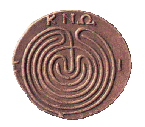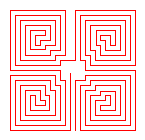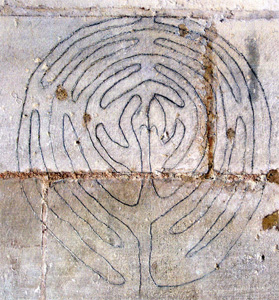
page 1
| The labyrinth and |

page 1 |
the medieval church. |
| What actually is a labyrinth ? Labyrinths do exist more than 4000 years and can be found in many religious traditions in the world. They are an important part of various cultures as with the original inhabitants of America, the Greecs, the Kelts and the Maya's. The Hopi indians called the labyrinth the symbol for "Mother Earth". Just as Stonehenge and the pyramids are they magical geometrical shapes that define a holy place. Various shapes of labyrinths are, among others, found in Peru, Arizona, Iceland, Europe and India. The oldest labyrinth we know is that of Crete, which is already mentioned in the Greec mythology and which was built by Daedalus. Pictures of this labyrinth have been found on pottery and coins in Knossos on Crete of 2000 to 2500 years BC, on rocks in Wales(UK) and in Rocky Valley, Cornwall(UK) as well as with the Hopi indians. Striking is that a cross forms the base of a labyrinth. |
 |
 |
 The entrance is above, the path is the red line. |
In the Middle Ages a labyrinth was placed in many churches as to symbolize a pilgrimage to the Holy Land. The oldest christian labyrinth, constructed in 328, can be found as a Roman mosaic in the basilica of San Reparatus near Orléansville which was renamed in el-Asnam (Algeria)in 1964 and in 1981 in Ech-Cheliff but it is also called Chlef. Its shape is a spiral and the the same time a square as was common with the Romans. In those days Orléansville was called Castellum Tingitanum. In the center is the text "SANCTA ECCLESIA". See picture (left). |
|
One of the most famous labyrinths - dating from about 1200 AD - can be found on the floor of the cathedral in Chartres in France.
Also here the cross can be clearly recognized and it seems to divide the labyrinth into four parts. Until some years ago there were chairs on the
labyrinth and on special occasions these were removed. These occasions were : marriage, baptism, funeral or other celebrations. |
|
On entering a labyrinth, you enter a holy space and time. When the mind is ready for it, a labyrinth can be used as a path for prayer
and meditation or remorse. In the latter case one walked on the knees. In the past a walk on the knees was more common and thus it took
an hour to get to the center. In those days a labyrinth was also called "Road to Jerusalem" (Chemin de Jerusalem) and in Chartres "the
mile" (la lieu, about 4 km, an hours walk). In many cathedrals labyrinths have been destroyed and again reconstructed. The labyrinths of Chartres and Saint Quentin are in their original state. Click with your mouse on the labyrinth of Chartres - left - then you see a photograph. Clicking again shows a plan of the labyrinth of Basilica of Saint Quentin, dating from 1493. Clicking on this plan shows a photograph. The length of the path of the labyrinth of Chartres is 260 meters, just as long as the way Christ walked from the court to Golgotha. The center symbolizes Jerusalem. Through the ages mankind was touched by the miraculous healing powers of the labyrinth and its enormous power to inspire. The labyrinths of Saint Quentin and Amiens are alike though the labyrinth of Amiens dates from the 13th century The center of the labyrinth of Saint Quentin is black. The labyrinth of Amiens has a very special center. Click arrow below for an animation with sound and further information. |
|
|

|
Left you see a drawing of a labyrinth in the cathedral of Saint Pierre in Poitiers, France.
There is however, something peculiar about this labyrinth. There is a mistake in it. This is, I think, in fact unthinkable as the dealing with
labyrinths in churches was such a precise work, that the mistake may have been caused by restauration work in later ages. |
| Back to index page | Labyrinth - page 1 | Continue to Labyrinth - page 2 |